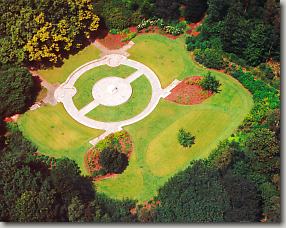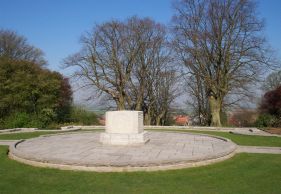Bourlon Wood Canadian Memorial
Today, the Bourlon Wood Canadian Memorial commemorates the attack across the Canal Du Nord on ground donated by the Comte de Franqueville, then Mayor of Bourlon. The great stone block is at the top of a hill. It is approached by climbing steep, stone steps past terraces cut into the hillside, and bears the message:
THE CANADIAN CORPS ON 27TH SEP. 1918 FORCED THE CANAL DU NORD AND CAPTURED THIS HILL. THEY TOOK CAMBRAI, DENAIN, VALENCIENNES & MONS; THEN MARCHED TO THE RHINE WITH THE VICTORIOUS ALLIES
Ancient lime trees line both sides of the steps that lead to the Memorial. They are the original trees, and though shattered by shellfire in the battle, they were nursed back to health. The terraces are planted with a rich variety of coniferous shrubs and shade-loving plants. The Memorial is beyond the village of Bourlon, which is just south of the Arras-Cambrai road, three kilometres beyond Marquion.
Canal du Nord, 1918
On September 3, 1918, the day after the Canadian Corps breached the Drocourt-Quéant Line, a directive was issued for a general Allied offensive on the entire front from the Meuse to the English Channel, with four great hammer-strokes to be delivered at crucial points. The timetable for these blows called for striking the enemy on four successive days. The second of these assaults was to take place on September 27, and was a joint attack by the First and Third British Armies in the general direction of Cambrai to capture the northern part of the Hindenburg Line. Field-Marshal Sir Douglas Haig ordered the First Army to seize Bourlon Wood and cover the Third Army's left flank as the latter advanced on Cambrai and subsequently on to Valenciennes. The capture of Bourlon Wood was assigned to the Canadian Corps, which would then push forward to establish a defensive flank northeast of Cambrai. Farther south the British Fourth Army, supported by the French First Army, would join the battle on September 29 in an assault on the main Hindenburg position.
The first obstacle General Sir Arthur Currie's forces had to overcome was the Canal du Nord. Because the Canal du Nord was impassable on the northern part of his front, General Currie had his boundary with the Third Army shifted 2,377 metres to the south, and proceeded with preparations for the Canadian Corps to make its initial attack through a dry area between Sains-lez-Marquion and Moeuvres. It was an intricate operation introducing the difficult problem of moving the whole Corps through a narrow opening before fanning out with four divisions engaged on a battlefront that would rapidly expand to over 10,000 metres.
In the dusk of the evening of 26 September the Canadians moved forward. By midnight they were assembled opposite the dry section of the canal, huddled together for warmth, and for the most part in the open. The night wore on and there was no evidence of enemy counter-preparation. Suddenly, as dawn was breaking, the opening barrage flashed out, shocking the enemy into action. Before they could retaliate, the initial waves had crossed the canal and were fanning out from the bridgehead. Nevertheless, the follow-up troops suffered casualties as the enemy, alive to the danger, subjected the canal bed to a violent bombardment. The results justified Currie's generalship. He acquired the canal at relatively light cost, but more than that, Bourlon Wood the essential objective, was also taken.
The Canadians then went on to free Cambrai. After leaving the Amiens front the Corps had liberated 54 towns and villages standing on more than 300 square kilometres of French soil. In its hard fighting the Corps suffered more than 20,000 casualties.
On the night of November 10-11 the Canadians entered Mons. The return had been long and arduous and the hard years of the war a bitter experience. Then, on November 11 at eleven o'clock the Armistice was in effect, and hostilities ceased.
Directions

The Bourlon Wood Canadian Memorial is about 10 kms west of Cambrai, 30 kms east of Arras, 40 kms south of Lille and 150 kms north of Paris. You can reach Cambrai by train or by bus and from there take a taxi to the Memorial. The trip to the Memorial is approximately €20 return. You can rent a bike at the train station; which costs approximately €5 per day, €11 per week and €17 per month.
Note: The cost of a taxi is based on return trips without a waiting period. If you want the taxi to wait for you while you visit the site you will be charged € 17.90 per hour. Bus connections are difficult and there are not many of them in the rural areas of the department du Nord.
If you are travelling by car, please follow the directions below:
Note: Speed limits in France are 50 km/h in city limits and residential areas (generally unmarked), usually 90 km/h on secondary roads (but it may vary in areas) and 130 km/h on the motorway.
From Paris or Charles de Gaulle Airport take the A1 motorway, direction Lille. Continue on this road, then take the A2, direction Valenciennes, then the A26, direction Calais. Take exit 8 for Cambrai and continue approximately 4 kms. Take the right turn into the village of Bourlon after the Canadian sign, then follow the traditional black and white signs with a maple leaf to access the Memorial. It should take you approximately 1 1/2 to 2 hours to reach the Memorial.
From Cambrai take the D939, direction Arras. Take the left turn into the village of Bourlon after the Canadian sign, then follow the traditional black and white signs with a maple leaf to access the Memorial. It should take you approximately 15 minutes to reach the Memorial.
From Arras take the D939, direction Cambrai. Take the right turn into the village of Bourlon after the Canadian sign, then follow the traditional black and white signs with a maple leaf to access the Memorial. It should take you approximately 40 minutes to reach the Memorial.
From Calais take the A26 and continue on this road for approximately 150 kms. Take exit 8 for Cambrai and continue approximately 4 kms. Take the right turn into the village of Bourlon after the Canadian sign, then follow the traditional black and white signs with a maple leaf to access the Memorial. It should take you approximately 1 1/2 to 2 hours to reach the Memorial.
From Lille take the A1, direction Paris. Continue on this road for approximately 35 kms. Take the A26, direction Reims, then exit 8 for Cambrai on the D939. Take the right turn into the village of Bourlon after the Canadian sign, then follow the traditional black and white signs with a maple leaf to access the Memorial. It should take you approximately 45 minutes to reach the Memorial.
- Date modified:
